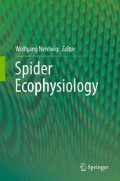Abstract
Tarsal morphology of spiders differs from species to species, reflecting adaptations to habitat demands. Jumping spiders (Salticidae) rely on the hierarchically structured claw tuft (scopula) to firmly attach to smooth surfaces. This scopula consists of single hairs (setae) covered by numerous cuticular processes (setules). These setules are the direct contacting elements of the attachment system. Adhesion does not depend on secreted fluids but employs short-ranging van der Waals forces. The estimated 624,000 setules in the spider Evarcha arcuata allow for a theoretical safety factor of 160 times the spider´s average weight. Strong adhesion is balanced by easy detachment through an asymmetric design of the setules’ distal ends. Detachment is controlled in an integrated manner via leg kinematics. The combination of dry adhesion, functional also in vacuum, substrate compliant hierarchical structure, and switchable adhesive properties, perfectly qualifies for biomimetic transfer. To be able to transfer the adhesive performance like the one of the salticid spider E. arcuata to a technical design, it is necessary to analyze the individual contributions of adhesion, compliance, and detachment.
Access this chapter
Tax calculation will be finalised at checkout
Purchases are for personal use only
References
Arzt E, Gorb E, Spolenak R (2003) From micro to nano contacts in biological attachment devices. Proc Natl Acad Sci 100:10603–10606
Autumn K, Peattie AM (2002) Mechanisms of adhesion in geckos. Integr Comp Biol 42: 1081–1090
Betz O, Kölsch G (2004) The role of adhesion in prey capture and predator defence in arthropods. Arthrop Struct Develop 33:3–30
Bhushan B, Peressadko TW, Kim AG (2006) Adhesion analysis of two-level hierarchical morphology in natural attachment systems for “smart adhesion”. J Adhes Sci Technol 20: 1475–1491
Gao H, Wang X, Yao H, Gorb S, Arzt E (2005) Mechanics of hierarchical adhesion structures of geckos. Mech Mater 37:275–285
Gasparetto A, Vidoni R, Seidl T (2008) Kinematic study of the spider system in a biomimetic perspective. In: Proceedings of the IEEE/RSJ international conference on intelligent robots and systems, Nice, France
Gasparetto A, Seidl T, Vidoni R (2009) A mechanical model for the adhesion of spiders to nominally flat surfaces. J Bionic Eng 6:135–142
Gasparetto A, Vidoni R, Seidl T (2010) Passive control of attachment in legged space robots. Appl Bionics Biomech 7:69–81
Hansen WR, Autumn K (2005) Evidence for self-cleaning in gecko setae. Proc Natl Acad Sci 102: 385–389
Hill DE (1977) The pretarsus of salticid spiders. Zool J Linn Soc 60:319–338
Johnson KL, Kendall K, Roberts AD (1971) Surface energy and the contact of elastic solids. Proc R Soc London A 324:301–313
Kesel AB, Martin A, Seidl T (2003) Adhesion measurements on the attachment devices of the jumping spider Evarcha arcuata. J Exp Biol 206:2733–2738. doi:10.1242/jeb.00478
Kesel AB, Martin A, Seidl T (2004) Getting a grip on spider attachment: an AFM approach to microstructure adhesion in arthropods. Smart Mater Struct 13:512–518. doi:10.1088/0964-1726/13/3/009
Li Y, Ahmed A, Sameoto D, Menon C (2012) Abigaille II: toward the development of a spider-inspired climbing robot. Robotica 30:79–89
Martin A, Dillinger SCG, Kesel AB, Nachtigall W (2002a) The structure of tarsal attachment elements in Araneae. Zoology 105(35 Suppl):95
Martin A, Seidl T, Kesel AB (2002b) Das mikro-mechanische Haftsystem der Spinne Evarcha arcuata. In: Wisser A, Nachtigall W (eds) Biona-Report 16:226–230
Menon C, Li Y, Sameoto D, Martens C (2008) Abigaille-I: towards the development of a spider-inspired climbing robot for space use. In: IEEE RAS/EMBS international conference on biomedical robotics and biomechatronics, Scottsdale
Niederegger (2013) Functional aspects of spider scopulae. In: Nentwig W (ed) Spider ecophysiology. Springer, Berlin (this volume)
Rovner JS (1978) Adhesive hairs in spiders: behavioral functions and hydraulically mediated movement. Symp Zool Soc Lond 42:99–108
Sameoto D, Menon C (2010) Recent advances in the fabrication and adhesion testing of biomimetic dry adhesives. Smart Mater Struct 19:103001
Sitti M, Fearing RS (2003) Synthetic gecko foot-hair for micro/nano structures as dry adhesives. J Adhes Sci Technol 18:1055–1074
Vidoni R, Gasparetto A (2011) Efficient force distribution and leg posture for a bio-inspired spider robot. Rob Auton Syst 59:142–150
Zhang H, Guo DJ, Dai ZD (2010) Progress on gecko-inspired micro/nano-adhesion arrays. Chin Sci Bull – Bionic Eng 55:1843–1850. doi:10.1007/s11434-010-3065-z
Author information
Authors and Affiliations
Corresponding author
Editor information
Editors and Affiliations
Rights and permissions
Copyright information
© 2013 Springer-Verlag Berlin Heidelberg
About this chapter
Cite this chapter
Seidl, T., Vidoni, R. (2013). Adhesion to Flat Surfaces: From Spiders to Stickers. In: Nentwig, W. (eds) Spider Ecophysiology. Springer, Berlin, Heidelberg. https://doi.org/10.1007/978-3-642-33989-9_35
Download citation
DOI: https://doi.org/10.1007/978-3-642-33989-9_35
Published:
Publisher Name: Springer, Berlin, Heidelberg
Print ISBN: 978-3-642-33988-2
Online ISBN: 978-3-642-33989-9
eBook Packages: Biomedical and Life SciencesBiomedical and Life Sciences (R0)

